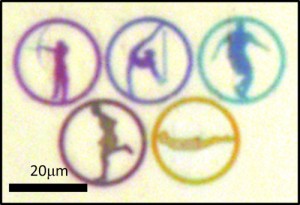 Color is all about the wavelength of light that comes off an object. A chemical, a pigment called anthocyanin is what makes an apple red. But sometimes an object doesn’t have a particular color because of pigment. You can also make something appear to have color using physical structures that are on the nanometer scale. If you have a bunch of ridges that are spaced out about 600 nanometers or so, then red light will be diffracted and the object will appear ‘red’. Peacocks and those blue morpho butterflies have color not because of pigments but because of tiny structures that diffract just certain wavelengths of light. The problem is that the color produced by these ridges is very particular about the angle that you view them at. Now scientists are making displays that show color but at less sensitive to the angle at which they are viewed. These new types of structures are less sensitive to the angle at which they are viewed. They hold promise for a new generation of displays that won’t involve pigments but just these tiny ridges.
Color is all about the wavelength of light that comes off an object. A chemical, a pigment called anthocyanin is what makes an apple red. But sometimes an object doesn’t have a particular color because of pigment. You can also make something appear to have color using physical structures that are on the nanometer scale. If you have a bunch of ridges that are spaced out about 600 nanometers or so, then red light will be diffracted and the object will appear ‘red’. Peacocks and those blue morpho butterflies have color not because of pigments but because of tiny structures that diffract just certain wavelengths of light. The problem is that the color produced by these ridges is very particular about the angle that you view them at. Now scientists are making displays that show color but at less sensitive to the angle at which they are viewed. These new types of structures are less sensitive to the angle at which they are viewed. They hold promise for a new generation of displays that won’t involve pigments but just these tiny ridges.
Read more
